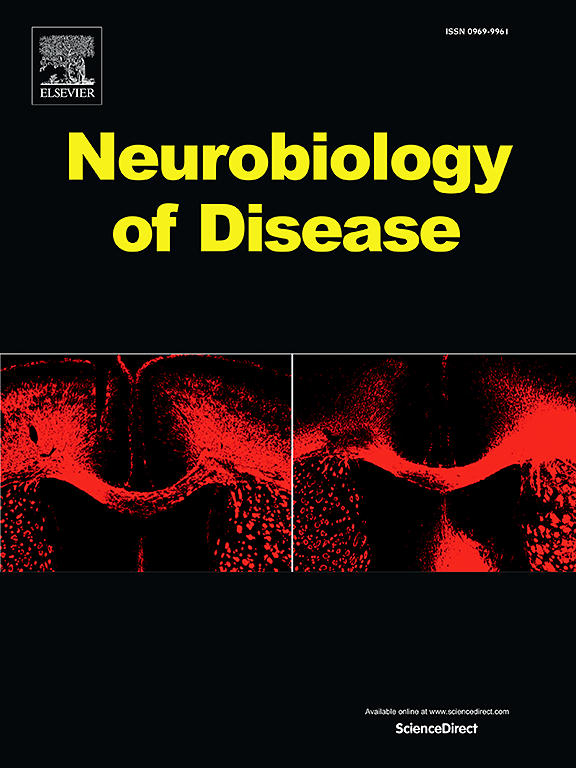Nusinersen纠正严重脊髓性肌萎缩症患者脑脊液中l -精氨酸缺乏。
IF 5.6
2区 医学
Q1 NEUROSCIENCES
引用次数: 0
摘要
脊髓性肌萎缩症(SMA)是一种进行性神经肌肉疾病,由存活运动神经元1 (SMN1)基因纯合缺失引起,导致SMN蛋白表达减少。越来越多的证据表明SMA的病理生理中存在神经传递缺陷。特别是,最近在smap患者的脑脊液(CSF)和SMNΔ7小鼠模型的脊髓中发现了参与谷氨酸能神经传递的神经活性氨基酸的改变。l -精氨酸是一氧化氮的前体,在谷氨酸受体信号传导中起关键作用,影响神经递质释放、突触可塑性和神经保护。然而,尚不清楚SMN缺乏是否会影响SMA的l -精氨酸代谢。为了解决这个问题,我们使用高效液相色谱法研究SMN缺乏是否会改变SMNΔ7小鼠中枢神经系统和不同疾病严重程度的SMA患者脑脊液中的l -精氨酸稳态,无论是在SMN诱导疗法Nusinersen治疗前后。值得注意的是,我们观察到症状性SMA小鼠的脑干和脊髓中的l -精氨酸水平明显低于同龄野生型小鼠。与这些发现一致,我们发现重度SMA1患者的l -精氨酸水平低于轻度SMA2和SMA3患者和健康对照,增强了我们研究结果的翻译强度。重要的是,nusinersen介导的SMN上调完全恢复了严重SMA1患者脑脊液中的l -精氨酸稳态。总之,我们的研究结果证明了SMA中l -精氨酸的失调,并强调了smn增强疗法在恢复这种神经退行性疾病患者观察到的神经化学改变方面的作用。本文章由计算机程序翻译,如有差异,请以英文原文为准。
Nusinersen corrects L-arginine deficiency in the cerebrospinal fluid of patients with severe spinal muscular atrophy
Spinal Muscular Atrophy (SMA) is a progressive neuromuscular disorder caused by homozygous loss of the survival motor neuron 1 (SMN1) gene, leading to reduced SMN protein expression. Increasing evidence implicates neurotransmission deficits in the pathophysiology of SMA. In particular, alterations in neuroactive amino acids involved in glutamatergic neurotransmission have recently been identified in both the cerebrospinal fluid (CSF) of SMApatients and the spinal cord of SMNΔ7 mouse models. L-arginine, a precursor of nitric oxide, plays a critical role in glutamatergic receptor signalling, influencing neurotransmitter release, synaptic plasticity, and neuroprotection. However, it remains unclear whether SMN deficiency affects L-arginine metabolism in SMA. To address this, we used high-performance liquid chromatography to investigate whether SMN deficiency alters L-arginine homeostasis in the central nervous system of SMNΔ7 mice and in the CSF of SMA patients with varying disease severity, both before and after treatment with the SMN-inducing therapy Nusinersen. Notably, we observed significantly reduced L-arginine levels in the brainstem and spinal cord of symptomatic SMA mice compared to age-matched wild-type littermates. Consistent with these findings, we revealed lower L-arginine levels in severe SMA1 patients compared to milder SMA2 and SMA3 patients and healthy controls, enhancing the translational strength of our findings. Importantly, Nusinersen-mediated SMN upregulation fully restored L-arginine homeostasis in the CSF of severe SMA1 patients. In conclusion, our results demonstrate a dysregulation of L-arginine in SMA and highlight a role for SMN-enhancing therapies in restoring neurochemical alterations observed in patients with this neurodegenerative disease.
求助全文
通过发布文献求助,成功后即可免费获取论文全文。
去求助
来源期刊

Neurobiology of Disease
医学-神经科学
CiteScore
11.20
自引率
3.30%
发文量
270
审稿时长
76 days
期刊介绍:
Neurobiology of Disease is a major international journal at the interface between basic and clinical neuroscience. The journal provides a forum for the publication of top quality research papers on: molecular and cellular definitions of disease mechanisms, the neural systems and underpinning behavioral disorders, the genetics of inherited neurological and psychiatric diseases, nervous system aging, and findings relevant to the development of new therapies.
 求助内容:
求助内容: 应助结果提醒方式:
应助结果提醒方式:


